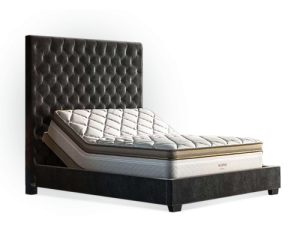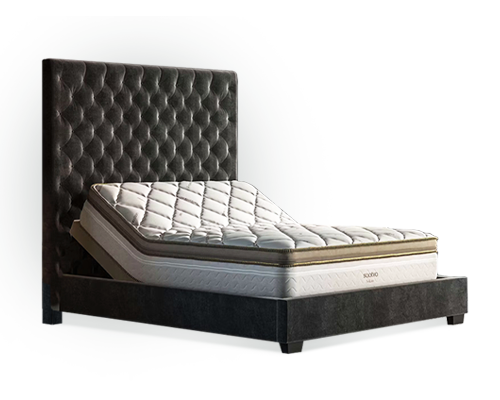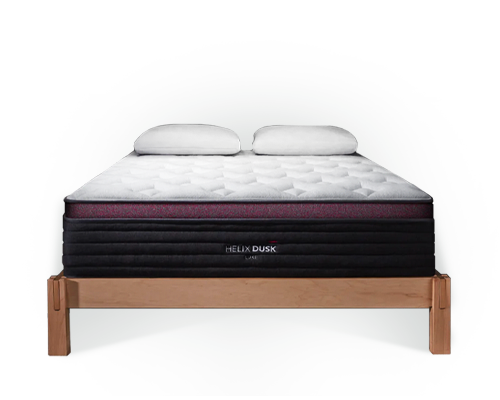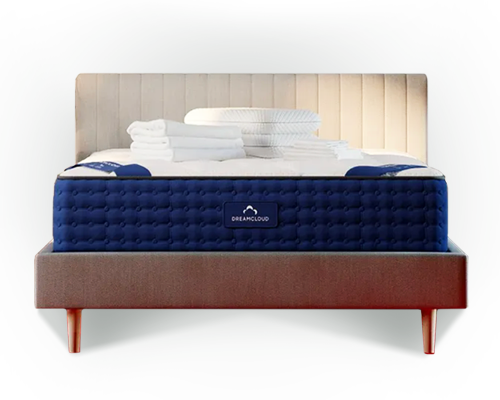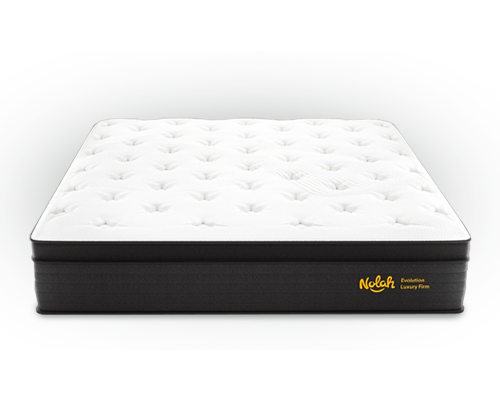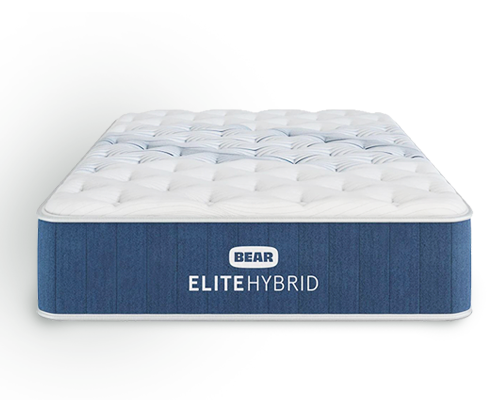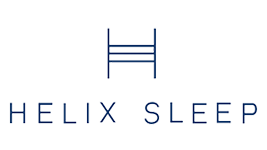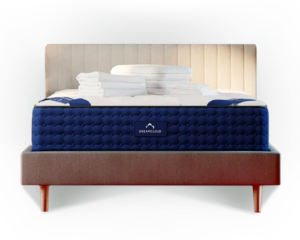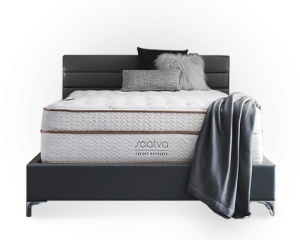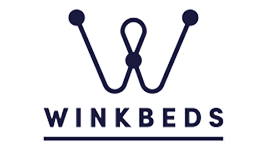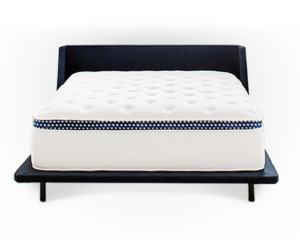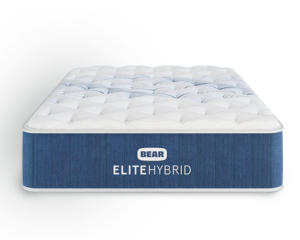- Price: $2,945 – $5,495
- Material: Hybrid
- Firmness: 5.5 – 7
- Trial period: 365 nights
- Shipping: Free white glove delivery and setup
- Warranty: Lifetime warranty
- Sizes: Twin XL, Full, Queen, King, California King, Split King, Split California King
- Mattress height: 13 inches (″)
Best Mattress for Scoliosis in 2025
Key Takeaways
- The best mattress for scoliosis is the Saatva Solaire because its adjustable firmness levels allow for personalized support, ensuring proper spinal alignment and reducing pressure on sensitive areas, which is crucial for those with scoliosis.
- Mattresses in our review cost between $839–$3,920, depending on the brand and size.
- Every mattress in this review is medium to firm and provides adequate surface support, pressure relief, and functional support for people with scoliosis.
- All featured brands meet or exceed the industry standard of a 100-night trial period so you have ample time to test your mattress in the comfort of your home.
- There is no one-size-fits-all solution for scoliosis, so if you’re unsure how a sleeping surface will impact your condition, it’s best to discuss options with your spine specialist and physical therapist.
Some adults have scoliosis from childhood, but age-related changes (like osteoporosis) can also influence your spine’s curvature. Up to 60% of adults may develop scoliosis with age [1] Kelly A, et al. Adult Degenerative Scoliosis—A Literature Review. Interdisciplinary Neurosurgery. June 2020. Found on the internet at https://www.sciencedirect.com/science/article/pii/S2214751919303846 . While many cases can be treated conservatively, it can still cause discomfort during daily activities or rest. If your scoliosis is disturbing your sleep, it’s time to talk to your doctor to make positive changes, including modifying sleep positions and improving sleep hygiene. In some cases, swapping a worn mattress for a new one might help.
After researching multiple mattresses and consulting medical professionals, we developed this review of the best mattresses for scoliosis. Although there is no one-size-fits-all option, we vetted each mattress to ensure they provide the following necessary features: a medium-to-firm feel, adequate surface support, great pressure relief, and the right materials to make it easy to change positions for those with mobility issues. Our best overall pick checks all these boxes, but ultimately, the best mattress is up to you. We hope our review helps.
Best overall mattress for scoliosis
According to our mattress testing and expert consultation, the Saatva Solaire is the best mattress for scoliosis because it offers the right support, pressure relief, and mobility-boosting features to accommodate a variety of sleepers.
Best mattresses for scoliosis in 2025
- Saatva Solaire: Best Overall
- Helix Dusk Luxe: Best Pillow Top
- DreamCloud Memory Foam: Best Mattress and Adjustable Bed Bundle
- Saatva Classic: Most Supportive
- The WinkBed: Most Comfortable
- Nolah Evolution 15″: Best for Back Sleepers
- Bear Elite Hybrid: Best for Pressure Relief
- Brooklyn Bedding Aurora Luxe: Best Firm
Table 1 Compare the best mattresses for scoliosis in 2025
| Mattress type | Hybrid | Hybrid | Foam | Innerspring | Hybrid | Hybrid | Hybrid | Hybrid |
| Firmness | Adjustable | Firm | Medium | Firm | Medium | Firm | Medium | Medium |
| White-glove delivery | Yes | No | Yes, bundle only | Yes | No | Yes | Yes | No |
| Trial period (nights) | 365 | 100 | 365 | 365 | 120 | 120 | 120 | 120 |
| Warranty (years) | Limited lifetime | 15 | Limited lifetime | Limited lifetime | Limited lifetime | Limited lifetime | Limited lifetime | 10 |
Best Mattress for Scoliosis Overall: Saatva Solaire
Our expert take on the Saatva Solaire mattress
When it comes to finding a mattress for scoliosis, the Saatva Solaire stands out as the best overall. This adjustable air mattress provides a customizable sleep experience.
According to our testers, the Saatva Solaire is adjustable between 5.5 and 7 firmness options. Our testing revealed that the mattress provides excellent lumbar support, especially in the back sleeping position. With a balanced feel, it contours to the body’s natural curves without sinking too deeply, which is crucial for maintaining a neutral spine—a must for anyone with scoliosis.
The pillow top layer delivers a plush feel that cradles the hips and shoulders, making it ideal for side sleepers. The mattress scored high in our pressure relief tests, especially at a firmness level of 20 mm.
The Solaire’s ability to adapt to different body shapes and sizes ensures that side sleepers with scoliosis can enjoy a comfortable and supportive night’s rest.
In terms of motion transfer, the Solaire performed admirably, with minimal disturbance reported when sharing the bed. This makes it a great option for couples, particularly when one partner is more restless.
However, it’s worth noting that the mattress might not be the best choice for stomach sleepers, regardless of firmness level. While excellent for back and side sleepers, the cushioning may cause hips to dip too low, leading to spinal misalignment.
Learn more in our in-depth review of the Saatva Solaire.
Best Pillow Top for Scoliosis: Helix Dusk Luxe
Our expert take on Helix Dusk Luxe mattress
The Helix Dusk Luxe is a hybrid mattress with a plush quilted top, responsive yet pressure-relieving foam, and bouncy coils. Testers perceived it to be slightly firmer than medium, scoring 7 out of 10 on the firmness scale (6.5 being the true medium firmness, according to industry standards). A firm, springy feel can provide greater functional supportⓘ We developed this term to describe how well the mattress supports bed mobility, like repositioning or getting out of bed. The better the functional support, the more assistance the mattress provides , which could be important for anyone needing a mobility boost as they change positions for comfort throughout the night using pillows or wedges.

We believe the Helix Dusk Luxe’s special features make it worth considering for those with chronic pain associated with their scoliosis. But, you should always discuss painful or difficult mobility with your occupational or physical therapist to incorporate strategies to make movement easier.
Although Helix claims this mattress is made for back and stomach sleepers, testers found it comfortable in every position, including most side sleepers who weigh more than 130 pounds (lighter-weight sleepers may find it too firm). This is due to the mattress’s zoned support, which uses reinforced coils along the center of the mattress with softer coils above and below. Zoned support provides resistance at the spine with pressure relief at the shoulder and hip, encouraging a more neutral spine position in most people. Depending on your spine’s curvature and specific treatment plan, this extra support can also benefit those with scoliosis. But it’s important to discuss nighttime positioning with your rehabilitation professional.
Our recommendation
Who may love it
- People of various body types who sleep in different positions
- Those with scoliosis and back pain who may benefit from a mattress with targeted support at the lower back
- Sleepers who want a high amount of pressure relief without sacrificing functional support for easier mobility in bed
Who may want to avoid it
- Lighter-weight side sleepers (less than 130 pounds) may perceive this mattress as too firm to provide adequate pressure relief
Learn more in our Helix Dusk Luxe review.
Best Mattress and Adjustable Bed Bundle: DreamCloud Memory Foam
Our expert take on DreamCloud Memory Foam mattress
If you’re looking for a mattress that can be used with an adjustable bed, the DreamCloud Memory Foam is a good option. Testers loved the DreamCloud Memory Foam for its denser foam, which provides more support and a true medium feel without sacrificing pressure relief. Softer foams allow you to sink far into the mattress, potentially reinforcing your spine’s abnormal curvature, depending on your sleep position.
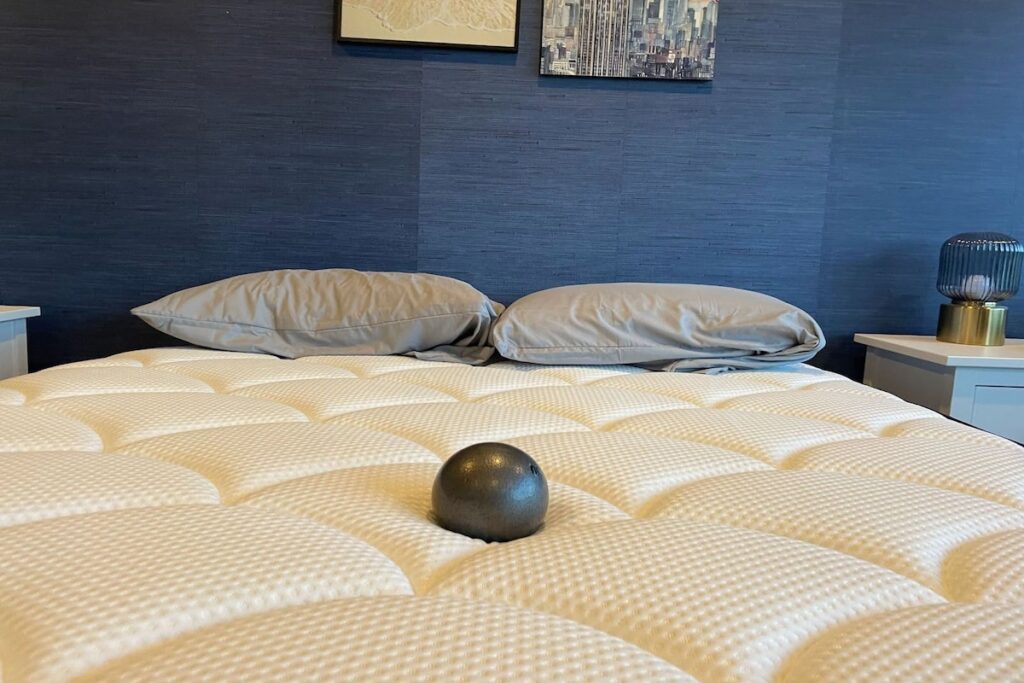
Our team also likes DreamCloud for its affordability. A queen-size DreamCloud Memory Foam mattress costs $1,532 at its regular price, but frequent promotions decrease the cost to about $800 making this an affordable mattress option. When you opt for the adjustable bed bundle, you can purchase a mattress and adjustable base for around $1,500, the same price as many mattresses or adjustable beds alone.
While most hybrid, latex, and foam mattresses are compatible with an adjustable bed, not all conform nicely to the bed’s adjustments. Thinner, more pliable mattresses worked best during our testing, molding to each adjustment with minimal gapping between the mattress and the base. The 12-inch DreamCloud Memory Foam mattress is a great fit for an adjustable bed because it’s thin enough to conform well, but still provides the firmness and support most people need for a comfortable night’s sleep on a flat surface.
An adjustable bed is useful for some people who feel comfortable (or relief) when elevating their head or feet. It’s similar to propping yourself with pillows but more convenient because you can control your position using a remote. While an adjustable bed can be a great tool, we recommend talking to your rehabilitation or orthopedic specialist about how and when to use its features. Depending on your treatment plan, you may only want to use adjustments as you wind down, then lie flat for the rest of the night.
DreamCloud offers a generous 365-night trial period and a limited lifetime warranty. Unfortunately, white-glove delivery is unavailable for the mattress alone. But if you opt for the adjustable bed bundle, it’s available for $199.
Our recommendation
Who may love it
- Those who love the pressure-relieving feel of an all-foam mattress without sag
- Anyone shopping for a new mattress on a budget
- Someone with back pain who feels relief by elevating their head or legs
Who may want to avoid it
- Lower-weight side sleepers may need more pressure relief under the hip and shoulder
- Those who can’t find help to move this mattress into their home after delivery
To learn more, read our DreamCloud mattress review.
Most Supportive: Saatva Classic
Our expert take on Saatva Classic mattress
Our team recommends the Saatva Classic if you prefer a supportive mattress with mobility-boosting features. We tested the luxury firm (medium firmness) model, which felt firm to our team. But this mattress has three firmness options, so you can go softer or firmer depending on what works best for you.
The Saatva Classic is one of the most supportive mattresses we’ve tested. While lying on this mattress, testers noted how strongly reinforced the center of the mattress felt. Saatva Classic offers zoned support along the lower back, similar to the Helix Dusk Luxe. But this mattress designed its support differently, reinforcing the central springs and adding an additional foam layer to its center. “The support is obvious when I [lie] on my back and side. The center of the mattress is notably stronger than the rest by design,” said one tester. “It meets and pushes into my body stronger than most other mattresses I’ve tried, yet my shoulder and hip don’t have too much pressure buildup.”
The same tester also noted how they needed to scoot down the mattress because of their short stature (5 feet and 3 inches tall) to ensure it supported them in the right places. For side sleepers with scoliosis, it’s worth asking a rehabilitation professional if a mattress with a reinforced center is appropriate and how to position yourself best.

Some back sleepers with scoliosis may not tolerate mattresses with strong zoned support, which is OK. If you’re wondering whether zoned support is a good option, test it at home by placing a thin pillow beneath your lower back for added reinforcement. The Saatva Classic could be a good option if this feels good after several nights.
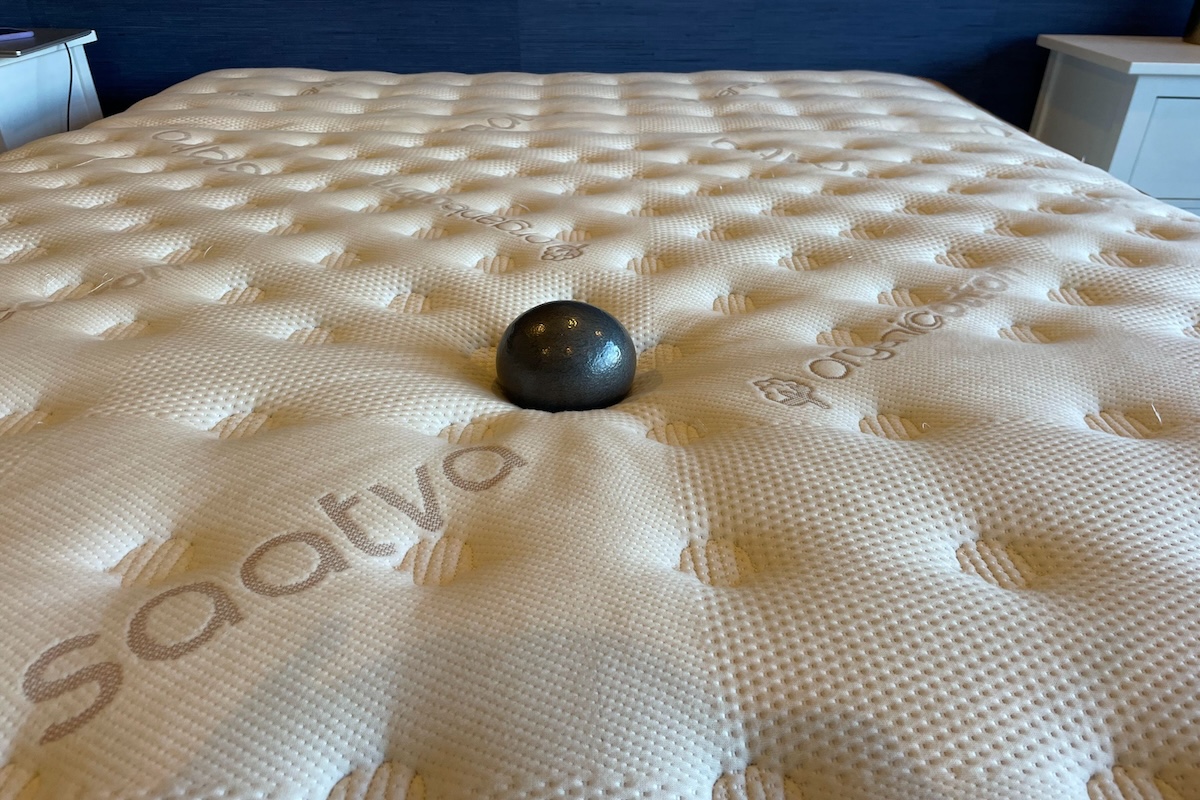
If you have pain or weakness associated with your back curve, you’ll appreciate this mattress’s bouncy innerspring build and top-rated functional support. “It’s much easier to roll, push up to sitting, and stand from the edge of the bed than less responsiveⓘ Responsiveness describes how much surface bounce a mattress has and how it responds to pressure or the sleeper’s movements, making it easier to move around and change sleeping positions. mattresses,” said the tester. “I can roll up to the edge without feeling like I’ll fall.”
Saatva offers free white-glove delivery for all its mattresses, so you don’t have to worry about setting it up yourself. You also get a limited lifetime warranty and a long 365-night trial period, which is plenty of time to try the mattress at home.
Our recommendation
Who may love it
- People who need a firm, supportive mattress to feel comfortable throughout the night
- Those who want a mattress that feels easy and safe to move on
- Anyone who needs white-glove delivery to help set up the mattress
Who may want to avoid it
- Lighter-weight side sleepers may prefer the softer version of this mattress for added pressure relief at the hip and shoulder
- Those shopping on a budget
To learn more about this brand, read out Saatva mattress review.
Most Comfortable: The WinkBed
Our expert take on The WinkBed mattress
If you’re looking for a cloud-like mattress without the sinking and unsupportive feel of a soft bed, the luxury firm (medium) version of The WinkBed is a great option. Soft beds can initially feel comfortable and pressure-relieving, but most experts we’ve consulted don’t recommend them because they run the risk of sagging. This is especially true for those with spine conditions where encouraging a neutral position is most beneficial.
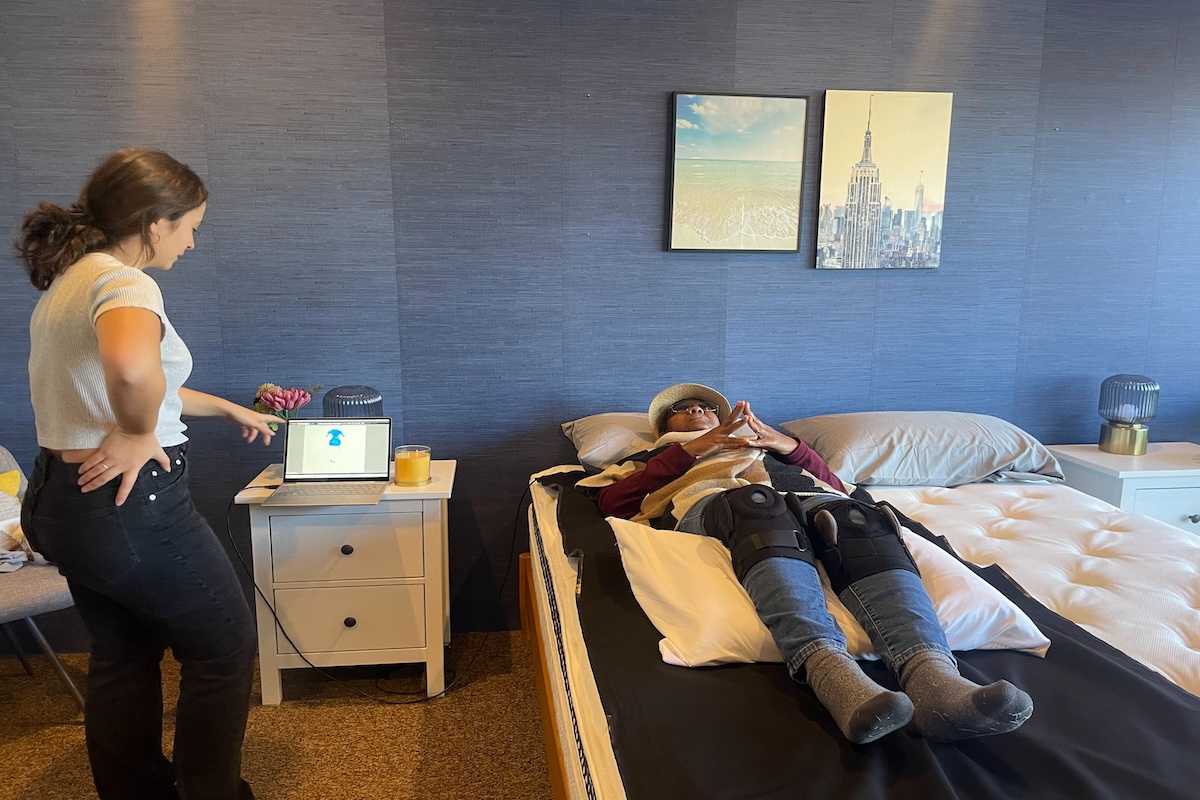
Our testers’ first impression was how responsive yet plush the top layers felt. “The top cradles my body, but I’m met with firmer support as I gently sink into the surface,” said one tester. This is due to the Euro pillow topⓘ A style of pillow top that provides an added layer of plush. The extra layer of padding is stitched beneath the mattress cover, so it’s flush with the edges of the mattress without adding extra height. , which provides a forgiving foam layer to offload pressure and help distribute body weight evenly across the top. Underneath the pillow top is a thick layer of bouncy coils with zoned support similar to the Helix Dusk Luxe (but not as strong as the Saatva Classic). The WinkBed balances pressure relief and support well, accommodating most sleep positions.
While it’s important to feel comfortable throughout the night, it’s also important to sleep undisturbed. This is especially true if you have pain associated with scoliosis because a quality night’s sleep is a key component of pain management [2] Staffe A, et al. Total Sleep Deprivation Increases Pain Sensitivity, Impairs Conditioned Pain Modulation, and Facilitates Temporal Summation of Pain in Healthy Participants. PLOS ONE. Dec. 4, 2019. Found on the internet at https://journals.plos.org/p . Finding a hybrid mattress with good motion isolationⓘ The ability of a mattress to keep movement on one side of the bed from affecting the other side. between partners is rare because of the springy coils, but testers were impressed to see The WinkBed perform well. “When I was lying on the mattress, and the other tester climbed into bed, I could barely feel a thing,” said our tester. In fact, The WinkBed also earned a spot in our review of the best mattresses for couples.
Also, our team recommends The WinkBed for those unsure of which firmness feels best for their condition. WinkBeds is unique because it offers an exchange program for $49, where you can ask to try a softer or firmer mattress. The brand will ship the new mattress to your home, and you can try both options for up to 60 days before returning one (or both). Like other bed-in-a-box mattresses, you don’t get white-glove delivery, so you’re responsible for arranging help ahead of time.
Our recommendation
Who may love it
- Those looking for a medium feel with great pressure relief
- Most back, side, and combination sleepers who benefit from zoned support
- Those who aren’t sure which firmness level is right for their needs
Who may want to avoid it
- Higher-weight stomach sleepers may not feel supported
- Those who can’t find help to move this mattress into their home after delivery
Our WinkBeds mattress review shares more, if you are interested in this mattress.
Best for Back Sleepers: Nolah Evolution 15″
Our expert take on Nolah Evolution 15″mattress
The Nolah Evolution 15″ is a great choice for back sleepers with scoliosis looking for targeted support under the lower back. While other mattresses in this review also offer zoned support, this option offers soft yet effective support using reinforced coils and a specific foam designed to encourage spinal alignment. We tested the luxury firm version, which felt slightly firm to our testers at seven out of 10 on the firmness scale. But you can opt for a softer or firmer version if you prefer.
Looking at a skeleton from the side, you’ll notice natural curves at the lower back and neck. Those with scoliosis have additional curves, rotating and swaying the spine to the side. Back sleepers can support their natural curvatures throughout the night and help promote the most neutral position possible, preventing awkward spine positions.
Nolah developed a unique type of foam called AirFoam, which is more dense along the center and less dense above and below. This allows the material to contour your spine, providing support under the lower back and distributing weight evenly across the mattress. “I sink into the softer first layer, then I’m met with a reinforced layer underneath. I can feel the material contour my lower back, but it’s not too much. It’s like a gentle hug,” said our tester.

Testers noticed the Nolah Evolution 15″ had more gentle support compared to Saatva Classic; it met the spine without extra reinforcement. If you’re a back sleeper who feels most comfortable with a pillow beneath the legs (which bends the spine slightly forward for relief), this mattress allows you to do so comfortably without working around reinforced material.
When you purchase this mattress, you get a 120-night trial period to try it out at home and a limited lifetime warranty. You can add white-glove delivery for $150–$300 depending on whether you need old mattress removal or additional services.
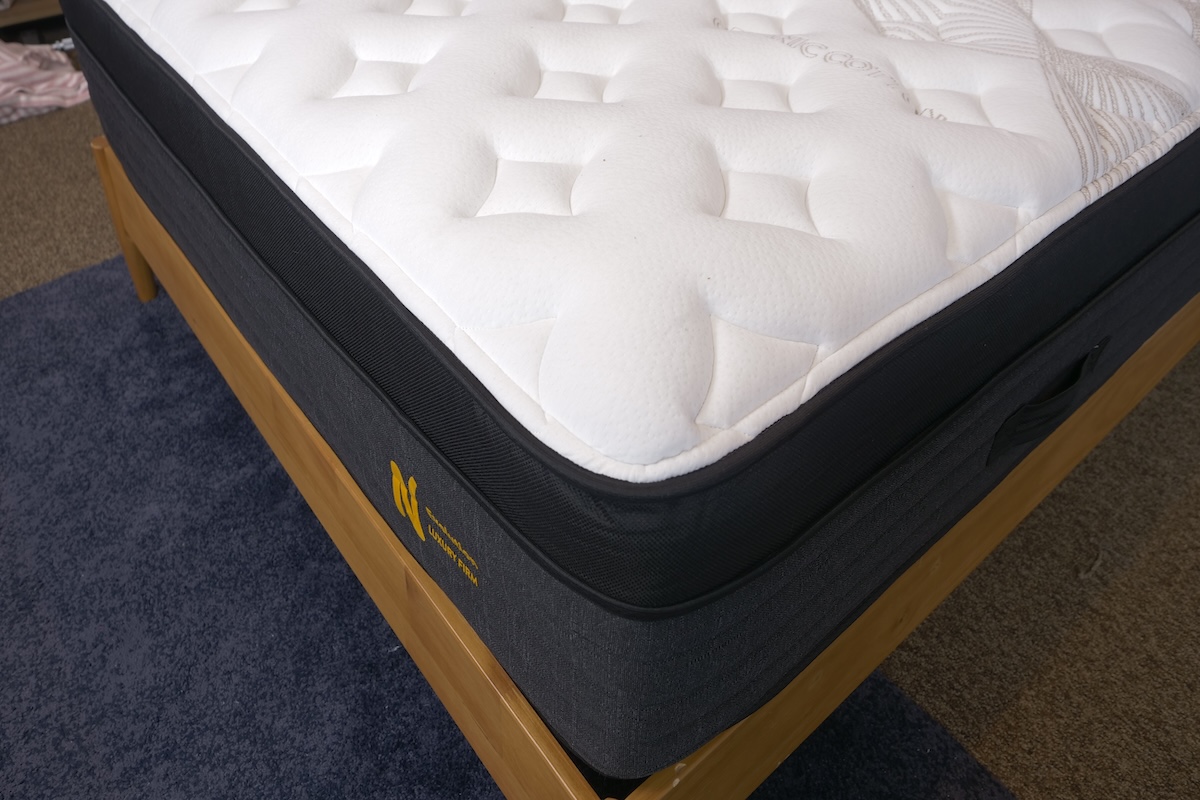
Our recommendation
Who may love it
- Back sleepers with scoliosis who benefit from zoned support
- Those who prefer firm mattresses but don’t want to sacrifice pressure relief
- People who need a tall, bouncy mattress for easier mobility in bed
- Anyone who needs white-glove delivery to help set up the mattress
Who may want to avoid it
- Shorter people may find it difficult to climb into this 15-inch-thick mattress if they have a tall bed frame
- Shoppers on a budget
Learn more in our Nolah mattress review.
Best for Pressure Relief: Bear Elite Hybrid
Our expert take on Bear Elite Hybrid mattress
The medium-firmness version of the Bear Hybrid Elite is among the few mattresses we’ve tested with maximum pressure relief, which prevents you from tossing and turning as you search for a better position. Those who spend time in bed while wearing a prescribed brace to manage scoliosis may also benefit from this mattress, as it distributes force away from uncomfortable edges and buckles.

Not every brace is appropriate for scoliosis. Your health care team may prescribe a custom brace to correct your unique curvature (although this treatment is rare for adult-onset scoliosis) or help recover from surgery if you’ve had one. Avoid using a generic brace until you discuss options with your orthopedist or physical therapist, as it may hinder your treatment.
Our testers used a pressure mapping systemⓘ A mat with sensors that detects pressure buildup when someone lies across it. to determine whether the Bear Elite Hybrid offered excellent pressure relief. Sensors on the pressure map signaled areas with high and low pressure buildup, sending a picture of the results to our computer. Blue and green body maps are considered good results, while yellow, orange, and red areas indicate pressure buildup.
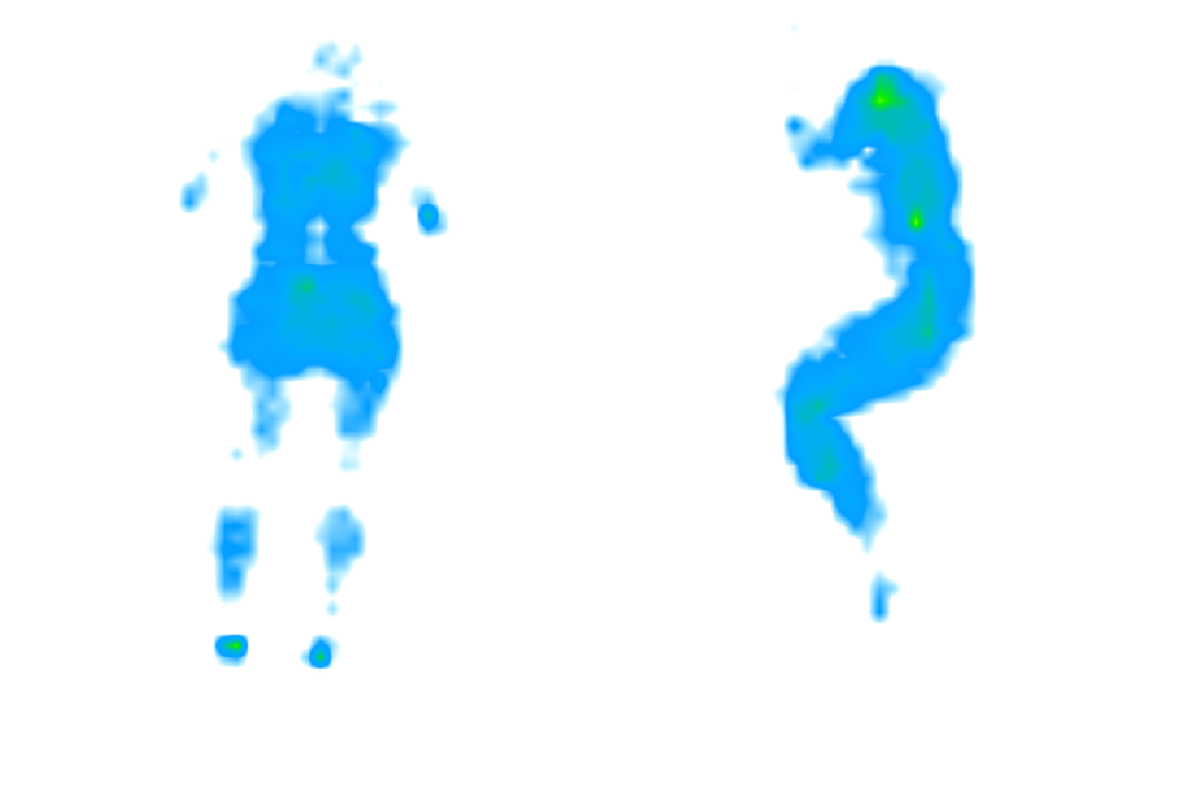
This mattress also offers subtle zoned support along the center enough to help distribute weight, but it’s not as reinforced as Saatva, Helix, or Nolah. If you like the idea of zoned support but are nervous about how you’ll tolerate it, the Bear Hybrid Elite is a good option.
The only downside to this mattress’s features is its functional support. It scored above average, which isn’t bad, but we don’t think it’s enough to assist those with painful mobility or weakness. Its thick layer of memory foam is comfortable but dampens bounce from the springs, and its edges aren’t as reinforced as we would like to see.
Like many other mattresses in this review, the Bear Elite Hybrid has a softer and firmer version available. You can opt for one or the other at checkout. Your purchase will come with a 120-night trial period, a limited lifetime warranty, and the option to add white-glove delivery for $175. But the white-glove delivery option is hidden under “Support” on the website’s footer as you scroll to the bottom of the page.
Our recommendation
Who may love it
- Those with sensitive joints, sore areas, or a brace who would benefit from maximum pressure relief
- People who like the idea of zoned support but aren’t sure if it’s for them
- Anyone who needs white-glove delivery to help set up the mattress
Who may want to avoid it
- Shoppers on a budget
- Those who need plenty of functional support to help change positions or get out of bed
Read our full Bear mattress review to learn more about this mattress.
Best Firm: Brooklyn Bedding Aurora Luxe
Our expert take on Brooklyn Bedding Aurora Luxe mattress
Our team tested the medium version of the Brooklyn Bedding Aurora Luxe. Although testers perceived this mattress as firm (7.5 out of 10 on the firmness scale), we were impressed by its ability to relieve pressure.
Most firm mattresses we’ve tested accumulate pressure around the hips and shoulders during side sleeping. But this mattress’s sturdy build strikes the right balance using subtle zoned support and multiple layers of dense memory foam to redistribute weight. In fact, its pressure map image looked strikingly similar to the Bear Elite Hybrid.

“The mattress feels pretty firm when you [lie] on it. But I feel no pressure on my joints as I change positions. The material slightly contours my body over time, but my spine doesn’t dip due to the built-in support. I feel even.”
– Our tester
The Brooklyn Bedding Aurora Luxe is a great option if you benefit from a firmer surface. Depending on your curvature, lying on your side on a firm mattress can assist your rehabilitation, but you’ll need to consult your physical therapist for specifics. Firmer surfaces are also easier to move on. This mattress earned a high functional support score, so you won’t fight the material as you roll or get out of bed.
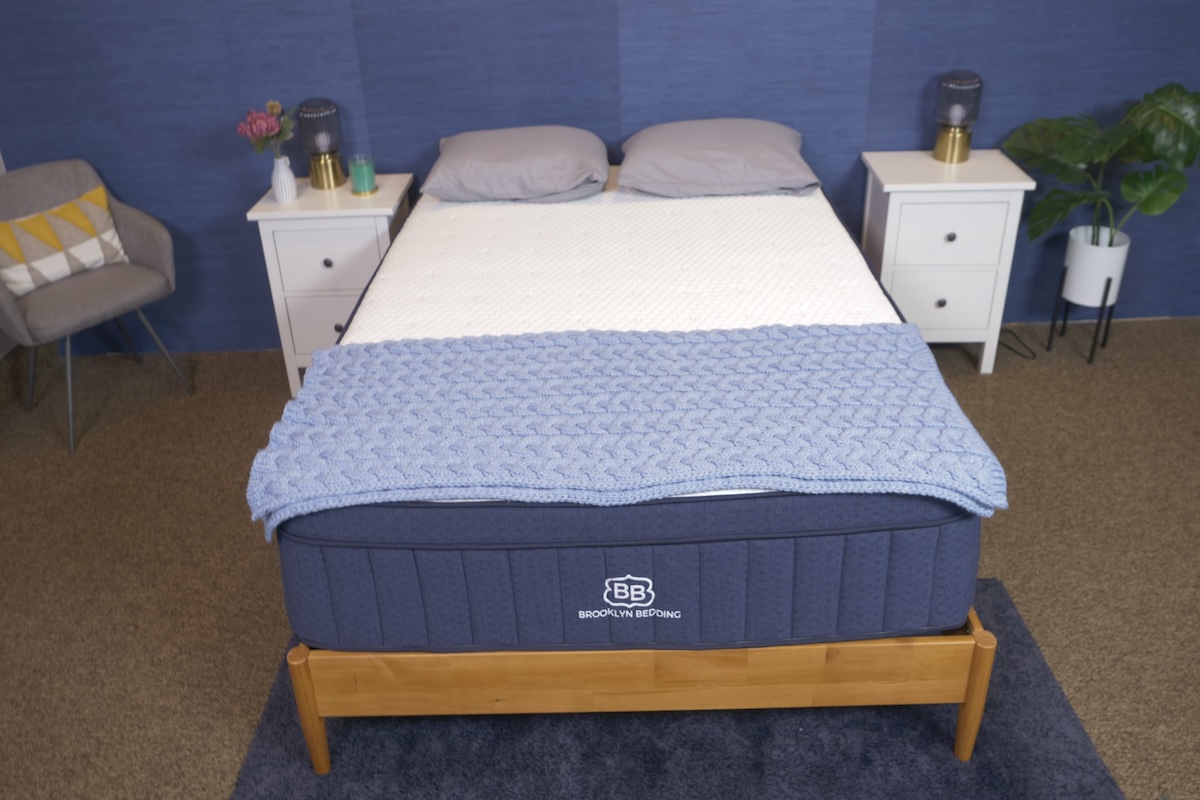
Testers felt the medium firmness version of this mattress erred firm, but you can go firmer at checkout. Your purchase has a 120-night trial period and a 10-year warranty, but white-glove delivery is unavailable. Be sure to arrange help to set it up when it arrives.
Check out more options in our review of the best firm mattresses.
Our recommendation
Who may love it
- People who benefit most from a firm, cool mattress
- Those with sensitive joints, sore areas, or a brace who would benefit from maximum pressure relief
- People who like the idea of zoned support but aren’t sure if it’s for them
- Those who want a mattress that feels easy and safe to move on
Who may want to avoid it
- Those who can’t find help to move this mattress into their home after delivery
- Couples who are sensitive to each other’s movements throughout the night
Read our Brooklyn Bedding mattress review to learn more.
What is scoliosis?
Scoliosis is a condition where the spine curves and rotates to the side. Every case is unique and can present with one curve (C-shaped) or two curves (S-shaped) to different degrees. Scoliosis is most commonly diagnosed among children around puberty as they grow.
Adult degenerative scoliosis (ADS), a term for scoliosis due to age-related changes, is present in up to 60% of older adults. The scoliosis is due to age related conditions like osteoporosis or spinal degenerative changes. Many cases are mild, but if it causes discomfort, it can be treated conservatively through physical therapy. More involved cases may require surgery.

Ask your doctor to refer you to a physical therapist with experience in treating scoliosis. Some are certified in the Schroth method, a treatment strategy that uses exercises and stretches to help stabilize your unique curvature.
Scoliosis and sleep
We asked Meredith Warner, orthopedic surgeon and owner of Well Theory in Baton Rouge, Louisiana, how scoliosis can affect sleep. “For some people, scoliosis can make it difficult to sleep comfortably,” she said. “For example, scoliosis can make the hips work harder during everyday movements. The hips can develop pain and irritation, making it hard to sleep due to direct pressure on the area. Scoliosis in the thoracic spine, or upper back, can similarly affect the shoulders.” The lower back, neck, and other body areas can also be affected.
If you suspect your scoliosis is causing pain or discomfort and negatively impacting your sleep, discuss your symptoms with your doctor. Lack of sleep can worsen symptoms, creating a vicious cycle [3] Staffe A, et al. Total Sleep Deprivation Increases Pain Sensitivity, Impairs Conditioned Pain Modulation, and Facilitates Temporal Summation of Pain in Healthy Participants. PLOS ONE. Dec. 4, 2019. Found on the internet at https://journals.plos.org/p . Your treatment plan may involve adjusting your sleep position or upgrading an old mattress. Check out our reviews of the best mattresses for back pain, shoulder pain, and hip pain for some of our recommendations, but make your choice aligns with the advice of your health care team.

Warner urges people to talk candidly with their doctor and stay open to more holistic evaluations and treatments. Even if a prominent condition like scoliosis is present, it doesn’t mean it’s the root cause of other issues, like disturbed sleep. “For some patients, I may actually recommend a sleep study because many reasons that a person doesn’t sleep well have nothing to do with pain at all. Rather, the person is awakened for some reason and then notices some discomfort before they notice anything else,” she said.
How we test the best mattresses for scoliosis
Our team has dedicated more than 1,000 hours to researching the mattress industry, consulting at least 10 health care professionals, and testing roughly 40 brands and 130 unique mattress models for quality and comfort. We’ve also interviewed eight older adults who recently purchased a mattress and surveyed more than 3,200 recent mattress customers to understand their experiences shopping for a new bed.
Each mattress undergoes a rigorous 36-page testing procedure to score its different characteristics, including firmness, support, and other aspects most shoppers consider. We choose the best mattresses for scoliosis based on the scores of the relevant criteria. See how we tested the most important considerations for this review below.
Firmness
Like most mattress brands in the industry, we use a one-to-10 scoring method when testing firmness, with 6.5 being the true medium firm. Our testers rate this by lying on the surface and comparing the feel to other mattresses we’ve tested. Material density and coil strength influence firmness the most. A medium to firm feel is best for those with back pain based on the conversations we’ve had with experts. Plus 71% of respondents to our survey of mattress buyers said they have a medium mattress or firmer, and a majority report being happy with their mattress choice.
Pressure relief
We rate pressure relief on a scale of one to five, with five being the most pressure-relieving. We consider how it feels and use a pressure map with sensors to visualize pressure points around the body accurately. Blue and green pressure map results show great pressure relief, while yellows, oranges, and reds indicate pressure build-up. Almost one-third (30.9%) of survey respondents with scoliosis sleep on their side, so we made sure to include mattresses with good pressure relief for side sleepers in this review. People with scoliosis may also have associated pain in their shoulders and hips, which can also potentially be eased with a pressure-relieving mattress.
Support
We score support on a scale of one to five, with five being the most supportive. Mattresses with strong support contour and push into the curves of your body, particularly the lower back or midsection. Not only do we feel support during testing, but we can also visualize it through pressure map results. Maps with mostly white space at the lower back show how the mattress isn’t making contact with the area, which means the mattress isn’t supportive. Adequate support helps keep the spine’s natural curves in a relatively neutral position, which is usually more comfortable. We were sure to include mattresses that provide enough support to cradle the spine’s natural curves.
Functional support
Our team developed this unique score to understand how well a mattress accommodates mobility issues, like difficulty moving around or getting up from the bed. We combined firmness (30%), support (30%), bounce (10%), and edge support (30%) to create a score between one and five, with five being the most helpful for movement in bed. This score was vital when researching the top mattresses with scoliosis. That’s because 89% of respondents to our survey with scoliosis reported having pain affects their mobility and makes it difficult to change positions and get in and out of bed.
For more information, see our sleep products review methodology.
How to choose a mattress if you have scoliosis
You should always discuss scoliosis management with your doctor or consult a physical therapist, especially if it’s impacting your sleep and daily functioning. Our review only intends to explain options based on our testing methods and expert consultation, but ultimately, the best choice is up to you.
What to look for in a mattress for scoliosis relief
Since scoliosis can vary drastically from person to person, we provided various options in our review. While there are many choices to make as you shop, like choosing the right mattress size for you and a partner, the following considerations can help you find the best mattress for your scoliosis:
- Firmness: Research generally recommends medium-to-firm mattresses to improve discomfort and boost sleep quality [4] Caggiari G, et al. What Type of Mattress Should Be Chosen to Avoid Back Pain and Improve Sleep Quality? Review of The Literature. Journal of Orthopaedics and Traumatology. Dec. 8, 2021. Found on the internet at https://jorthoptraumatol.springeropen.c . Recommendations for those with scoliosis are no different, and relatively firm mattresses are good adaptable surfaces for our bodies.
- Sleep position compatibility: When shopping for a new mattress, it’s always important to consider your favorite sleep position. Side sleepers may require more pressure relief at the hip and shoulder, while stomach and back sleepers need sturdy, supportive surfaces. Those with scoliosis have the same considerations, but if you’re working with a clinician who recommends specific nighttime positioning as part of your rehabilitation (perhaps with pillows or other types of support), it may be a good idea to discuss which options are most compatible with your long-term treatment plan. This is especially true if you’re considering an adjustable bed.
- Support: Our review features mattresses with different levels of support. For example, the Saatva Classic has strong support concentrated along the center of the mattress. The Helix Dusk Luxe and Bear Elite Hybrid have more gentle zoned support, while the DreamCloud Memory Foam doesn’t offer zoned support. One is not better than the other as long as it’s providing some level of support to prevent sag over time. It’s up to you to choose how much reinforcement you need under your spine for a good night’s sleep, and you can test this before investing in a mattress by using pillows to mimic support.
- Pressure relief: Scoliosis can cause stress in other body areas, like the hips and shoulders. Direct pressure can feel painful when irritated, so a pressure-relieving mattress is a good option. All mattresses in our review are good at redistributing force away from prominent joints, but the Bear Hybrid Elite and the Brooklyn Bedding Aurora Luxe are standouts.
- Functional support: If your scoliosis coincides with other symptoms, like lower body weakness, it can feel difficult to move and get out of bed. We developed functional support to describe how well a mattress encourages bed mobility based on firmness, edge support, surface support, and bounce. All mattresses in our review have an above-average rating, but some are more helpful than others, like the Saatva Classic.
- Body type: Your body size can influence how you perceive the feel of a mattress. Lighter-weight sleepers who weigh less than 130 pounds may think mattresses feel firmer than they are, while higher-weight sleepers who weigh more than 250 pounds may think mattresses feel softer. Check out our review of the best mattresses for higher-weight people for more options.
Pillows and scoliosis
Scoliosis can influence your neck, even if your curve sits lower on your spine. You can choose the right pillow for your preferred sleep position to encourage a more comfortable, neutral spine position. Read our review of the best pillows to browse some options, but if you have a curvature in your upper back or neck, it’s best to discuss options with your health care team first.
You can also use pillows as props. Back sleepers may find relief by placing a pillow under the lower back or legs, while side sleepers can place a pillow between the legs to encourage a more neutral spine position. Depending on your curve and treatment plan, rehabilitation specialists may advise placing pillows under specific body parts throughout the night to decrease your abnormal curves over time.
What type of mattress is best for scoliosis?
Mattresses are made with different materials, each with their own characteristics. Below are some of the most common materials, their advantages, and their disadvantages:
- Innerspring: These mattresses are designed with thick, coil-infused layers to offer plenty of bounce and support. It’s easy to move on innerspring mattresses, and they’re often on the firmer side. But they lack pressure relief, which can feel painful at the shoulder and hip. Most mattresses now incorporate a cushioning material to avoid this issue, regardless of your condition. Learn more in our review of the best spring mattresses.
- Foam: All-foam mattresses are designed to provide pressure relief and can be great for side sleepers. Memory foam is great for motion isolation, so partners are disturbed less by movement across the mattress. Because foam allows your body to sink into the surface, it’s notoriously heat-trapping and can make changing positions difficult. Some softer foams are prone to sag and potentially encourage your abnormal curve, so our team prefers all-foam mattresses on the denser side, like the DreamCloud Memory Foam. See more in our review of the best memory foam mattresses.
- Hybrid: Most mattresses in this review are hybrids because they incorporate the support and responsiveness of an innerspring with the pressure relief of foam. Based on our testing, hybrids err on the medium-to-firm side, making them a great option for those with scoliosis. Learn more in our review of the best hybrid mattresses.
- Latex: A latex mattress is a good choice if you prioritize eco-friendly materials. Latex is a natural alternative to foam, but it’s more responsive and sleeps cooler. Unfortunately, many latex options outprice foam and hybrid options, but it’s still a good choice if you want a balance between pressure relief and support. Those with scoliosis and accompanying mobility issues will appreciate how easy it is to move on a latex surface. Learn more about natural alternatives in our best organic mattresses review.
- Air: Adjustable air mattresses allow you to customize your firmness level. They are expensive but could be useful if your symptoms fluctuate and your sleep preferences change often. Sleep Number beds are popular, but the Saatva Solaire is a good alternative.
Your sleeping position and scoliosis
According to Warner, your ideal position depends on the location and extent of your curve. Some people with scoliosis may benefit from a specific position using pillows and bolsters, while mild cases may not need specific positioning. Nighttime positioning for your curve is a great topic to discuss with your health care team. Below are some considerations for each position as you browse mattresses:
- Back sleeping: When lying face-up, you’ll want to support your lower back’s natural sway by finding a mattress with adequate reinforcement (or using a pillow). For some, sleeping flat on the back can feel uncomfortable. Placing a pillow under the knees can take some pressure off the lower back and hips for a more comfortable sleep. We like the Nolah Evolution for those with scoliosis, but you can check out our best mattress for back sleepers review for other options.
- Side sleeping: Some side sleepers may benefit from support at specific pressure areas under the shoulder and hip while supporting the torso for a more comfortable sleep. You can read more in our review of the best mattresses for side sleepers, but the Bear Elite Hybrid or Brooklyn Bedding Aurora Luxe are two great options.
- Stomach sleeping: When you sleep on your stomach, you must rotate your head to the side to breathe. This may be tolerable for some people with scoliosis, but the higher your curve is on your spine, the more awkward (and potentially painful) the position may feel.
- Combination sleeping: Specialists say shifting around in your sleep is normal. People who swap positions throughout the night (known as combination sleepers) benefit most from a functionally supportive mattress with good motion isolation to prevent disturbing a partner. The WinkBed mattress in this review is a great option.
Bottom line
Finding a good mattress for scoliosis can be intimidating. If you’re concerned about purchasing the best mattress for scoliosis, it’s best to consult your doctor and ask how sleeping surfaces will impact your specific curve.
Based on our team’s research and testing, the Saatva Solaire is the best overall pick for scoliosis because its customizable firmness offers precise support, promoting spinal alignment and alleviating discomfort for those with scoliosis. But our review offers a variety of options. The DreamCloud Memory Foam mattress could be great if you’re considering an adjustable bed. And if you have sore hips or shoulders as a result of your scoliosis, consider the Brooklyn Bedding Aurora Luxe or Bear Elite Hybrid for excellent pressure relief.
Frequently asked questions
People with scoliosis have at least one abnormal curve in their spine. Unlike the typical curves in the lower back and neck that sway front and back, these abnormal curves sway to the side and cause the spine to rotate. A telltale sign of scoliosis is a “rib hump,” which appears when you bend forward and touch your toes and indicates rotation in your spine. People may also have asymmetrical hips and shoulders. And some might have pain, abnormal breathing, or nerve issues due to scoliosis. Symptoms vary greatly depending on the extent of the curvature, but mild to moderate cases are manageable without surgery.
Based on our testing, the DreamCloud Memory Foam mattress could be a good budget option if the features align with what’s most beneficial for you and your curvature. During frequent promotions, you can get this mattress in a queen for about $800.
Unless your mattress is old and worn, we recommend using pillows and wedges to prop your body into a more comfortable position before investing in a new bed. Positional changes can make a big difference. Consult a rehabilitation specialist, like a physical therapist, to learn how to position your body and its curves for a better night’s sleep.
Most clinicians we’ve consulted recommend choosing a medium-to-firm mattress. Softer mattresses are more likely to sag overnight (and over time), which can worsen scoliosis symptoms.
Back and side sleepers should sleep with a pillow under the head to promote a neutral spine and prevent awkward positioning throughout the night. People with scoliosis can also use pillows to prop their lower back or legs comfortably. For some back sleepers, placing a pillow under the knees can take some pressure off the lower back and hips for a more comfortable sleep. And some side sleepers may benefit from placing pillows under their torso to encourage better spinal alignment.
Have questions about this article? Email us at reviewsteam@ncoa.org.
Sources
1. Kelly A, et al. Adult Degenerative Scoliosis—A Literature Review. Interdisciplinary Neurosurgery. June 2020. Found on the internet at https://www.sciencedirect.com/science/article/pii/S2214751919303846
2. Staffe A, et al. Total Sleep Deprivation Increases Pain Sensitivity, Impairs Conditioned Pain Modulation, and Facilitates Temporal Summation of Pain in Healthy Participants. PLOS ONE. Dec. 4, 2019. Found on the internet at https://journals.plos.org/plosone/article?id=10.1371/journal.pone.0225849
3. Caggiari G, et al. What Type of Mattress Should Be Chosen to Avoid Back Pain and Improve Sleep Quality? Review of The Literature. Journal of Orthopaedics and Traumatology. Dec. 8, 2021. Found on the internet at https://jorthoptraumatol.springeropen.com/articles/10.1186/s10195-021-00616-5

